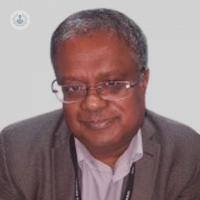All about carotid arteries
Written by:The carotid arteries, along with the vertebral arteries, are the major blood vessels responsible for the supply of blood to the brain. Any alteration in the amount of blood supplied has consequences. Vascular diseases of the brain, in particular, are one of the main causes of disability and this is why their study and prevention is fundamental.
Here, renowned consultant cardiologist, Dr Digoarachi S Bulugahapitiya, provides an expert insight into the different diseases that affect the carotid arteries and how these are surgically treated.

Where is the carotid artery located? What function does it fulfil?
There are two carotid arteries (right and left), both responsible for supplying blood to the brain. Both begin in the aorta within the thorax (aortic arch) and run through the side of the neck (protected by the sternocleidomastoid muscle). They are known as common carotids.
There are two branches at the mandible: the internal carotid, which irrigates the brain, and the external carotid, which irrigates part of the face and facial muscles.
What type of disorders can you have? How can they be detected?
Like other arteries, the carotid artery can suffer from different diseases.
The most frequent condition is stenosis or narrowing of the arteries. It usually appears after years of smoking, diabetes mellitus, high blood pressure, or high cholesterol. The main risk of carotid stenosis is that there is a deficit of arterial contribution to the brain in the form of cerebral embolisation, the detachment of atheromatous plaque that causes stenosis, or a decrease in blood flow in the brain known as cerebrovascular accident, which might be a stroke or transient ischaemic attack (TIA).
The most reliable way to detect carotid stenosis is by means of a Doppler ultrasound study. It is a non-invasive examination that is done on an outpatient basis in the same clinic as the angiologist and vascular surgeon. It enables the degree of stenosis to be measured, and the characteristics and evolution of the atherosclerotic plaque to be assessed, to determine the most appropriate treatment in each case.
In what cases is carotid surgery needed?
Given the risk of an arterial deficit in the brain when a carotid stenosis is detected, treatment should be started to control the risk factors and prevent its progression. Surgical repair is usually indicated when the stenosis exceeds 70 per cent carotid lumen narrowing, both in asymptomatic cases and in those with symptoms (patients who have already suffered a stroke due to stenosis).
What does carotid surgery involve?
The surgery for most cases of carotid stenosis is a carotid endarterectomy. It is an operation performed under general anaesthesia. An incision is made on the side of the neck, controlling the carotid artery at its bifurcation. A longitudinal opening of the artery is performed to remove the atheroma plaque that is causing the stenosis. This opening is closed with a prosthesis or patch to prevent further stenosis in the future. In some cases, shunt surgery is performed. This fits a system to control and regulate the arterial flow to the brain. The surgery lasts approximately 90 minutes and the patient spends the first 24 hours in an intensive care unit for immediate postoperative control.
Another technique is carotid revascularisation, also called carotid stent. Although it is a less aggressive technique (it is not necessary to make an incision in the neck, because surgery is performed on another artery, usually in the groin), its results are not as good and are reserved for those cases in which surgery can be more complex.
Are there risks?
The surgery is delicate and there are risks, but it is very important to point out that the risks of complications are much greater than the risks of the surgery or not having the surgery. In addition to the usual risks of any other intervention (haematoma, infection), the main risk of this operation is that there is a deficit of arterial contribution to the brain. However, despite being a delicate operation, the results of carotid endarterectomy are very good.
How long will the patient take to recover completely?
After 24 hours, the patient can get up in hospital and walk about and eat normally. The patient can return home three to four days later, and usual physical activities can be progressively resumed. Return to normal life is usually achieved in two weeks.
Dr Digoarachi S Bulugahapitiya is a leading consultant cardiologist with over 30 years' experience.
If you require carotid surgery and would like to consult your options with an expert, don't hesitate to book an appointment with Dr Bulugahapitiya via his Top Doctors profile today.


